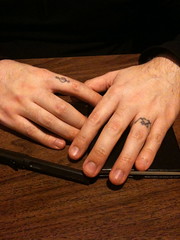Traduzione by CARLO CARADONNA, volontario di English Gratis. Il testo originale è tratto da una pagina del sito inglese di Wikinews ed è disponibile nel rispetto della licenza Creative Commons Attribution 2.5 ![]() photo credit: : zak_greant
photo credit: : zak_greant
Ambidextrous children more likely to have problems at school, say researchers
La tesi dei ricercatori: maggior probabilità di avere problemi a scuola per i bambini ambidestri
Monday, January 25, 2010
Lunedì, 25 Gennaio, 2010
Researchers say that ambidextrous children are at greater risk of difficulties at school, language problems, and disorders such as attention-deficit hyperactivity disorder (ADHD) than those who are left-handed or right-handed.
I ricercatori affermano che i bambini ambidestri siano a maggior rischio di incontrare difficoltà a scuola, di avere problemi nel linguaggio, e di contrarre disturbi quali il Disturbo da Deficit di Attenzione/Iperattività (DDAI) rispetto a coloro che sono mancini o destrimano.
Dr Alina Rodriguez, from the School of Public Health at Imperial College, London, and a team of researchers from various European universities studied nearly 8,000 children from the north of Finland; 87 of these were ambidextrous (mixed-handed).
La dottoressa Alina Rodriguez, della Scuola di Salute Pubblica all’Imperial College di Londra, e un team di ricercatori provenienti da varie università europee hanno studiato quasi 8.000 bambini originari della parte settentrionale della Finlandia; 87 di questi erano ambidestri (con lateralità mista nell’uso della mano).
Parents, teachers and the children themselves assessed language skills, academic achievement and behaviour.
I genitori, gli insegnanti e gli stessi bambini hanno valutato le capacità di linguaggio, il risultato scolastico e il comportamento.
>>> At ages 7 and 8, the ambidextrous children had double the rate of language problems and were twice as likely to have problems at school.
All’età di 7 e 8 anni, i bambini ambidestri avevano una doppia frequenza di problemi del linguaggio e per loro era doppia la probabilità di incontrare problemi a scuola.
Ambidextrous children in the study also had a higher rate of language problems.
I bambini ambidestri presi in considerazione nello studio avevano una più alta incidenza di problemi del linguaggio
The number of people who are ambidextrous is unclear, with estimates ranging from 1% to 5%.
Il numero di persone che sono ambidestre non è chiaro, con stime che vanno dall’1% al 5%.
Scientists do not know why some people use both hands when the majority of people prefer to use one predominantly.
Gli scienziati non sanno perché alcune persone usino entrambe le mani quando la maggioranza della popolazione preferisce usarne una in misura predominante.
The theory is that there is something different in the brains of ambidextrous people, although Rodriguez says that more work in the area is needed.
La teoria è che ci sia qualcosa di differente nel cervello delle persone ambidestre, anche se Rodriguez sostiene che in questo campo sia necessario un ulteriore lavoro di ricerca.
A person who prefers using their right hand will have a more dominant left hemisphere of the brain, which is the part of the brain for language skills.
Una persona che preferisce usare la mano destra avrà una prevalenza dell’emisfero sinistro del cervello, che è la parte (del cervello) che sovrintende alle capacità del linguaggio.
Rodriguez and her researchers have suggested that the right hemisphere of the brain of an ambidextrous child is weaker compared to that of a right-handed child .
Rodriguez e i ricercatori del suo gruppo hanno suggerito che l’emisfero destro del cervello di un bambino ambidestro sia più debole rispetto a quello di un bambino destrimano.
Previous suggestions about the causes of ADHD include the possibility that a person’s right hemisphere has weaker function.
Precedenti conclusioni suggerite in merito alle cause del Disturbo da Deficit di Attenzione/Iperattività (DDAI) comprendono (l’ipotesi della) possibilità che l’emisfero destro di un individuo abbia una funzione più debole.
Earlier studies have drawn links between dyslexia and being ambidextrous, and other studies are looking at the part that differences between the two sides of the brain play in language skills and psychosis.
Precedenti studi hanno tracciato dei collegamenti tra la dislessia e la condizione di ambidestro, e altri studi stanno prendendo in considerazione il ruolo che le differenze tre le due parti del cervello giocano nelle capacità di linguaggio e nella psicosi.
Rodriguez emphasised that the research, published in the journal Pediatrics in the United States, did not show that all ambidextrous children would have such problems, pointing out that most of the children in the survey did not develop them.
Rodriguez ha rimarcato che la ricerca, pubblicata nella rivista Pediatrics negli Stati Uniti, non ha messo in luce che tutti i bambini ambidestri avrebbero tali problemi, facendo presente che la maggior parte dei bambini esaminati nella ricerca non li hanno manifestati.
“Our study suggests that handedness is really a marker for atypical foetal brain development — showing that the brain is working in a different way to the norm”, she said, adding that other studies have shown atypical brain development to be associated with extraordinary creativeness.
“Il nostro studio suggerisce che la lateralità nell’uso della mano è realmente un indicatore di uno sviluppo fetale del cervello atipico – mettendo in evidenza che il cervello opera in una maniera differente rispetto alla norma”, ha precisato, aggiungendo che altri studi hanno messo in luce le associazioni tra lo sviluppo atipico del cervello e la straordinaria creatività.
She also suggested that the results may assist schools and health care workers in targeting children at risk of problems.
Ha anche suggerito che i risultati possono essere di supporto per gli operatori scolastici e dell’assistenza sanitaria nell’individuazione dei bambini a rischio di problemi.



